
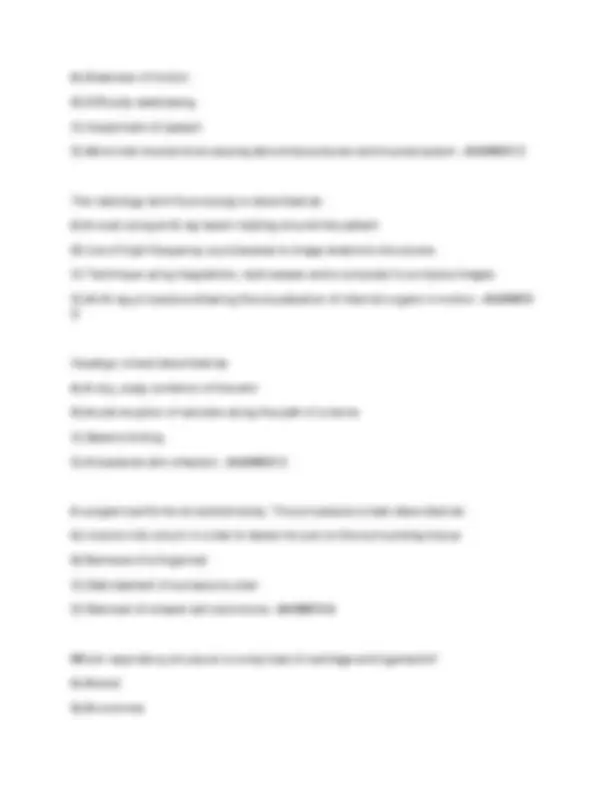
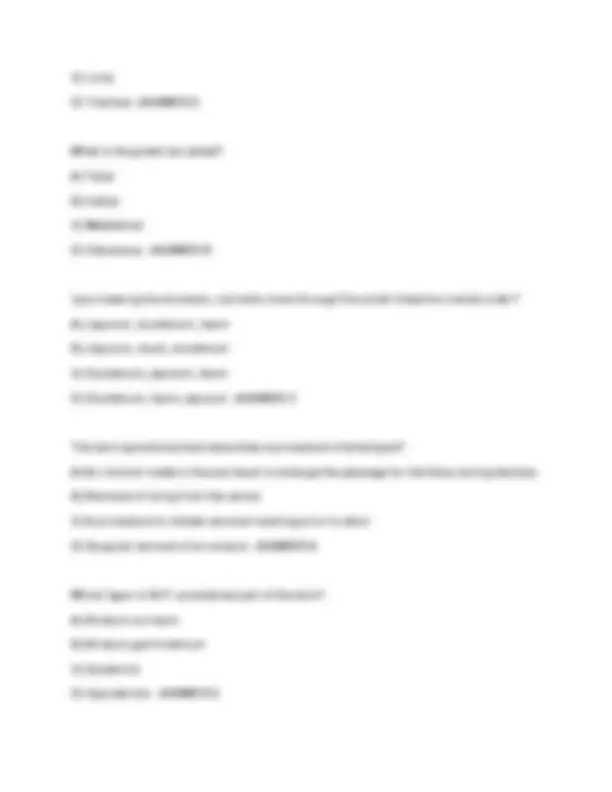
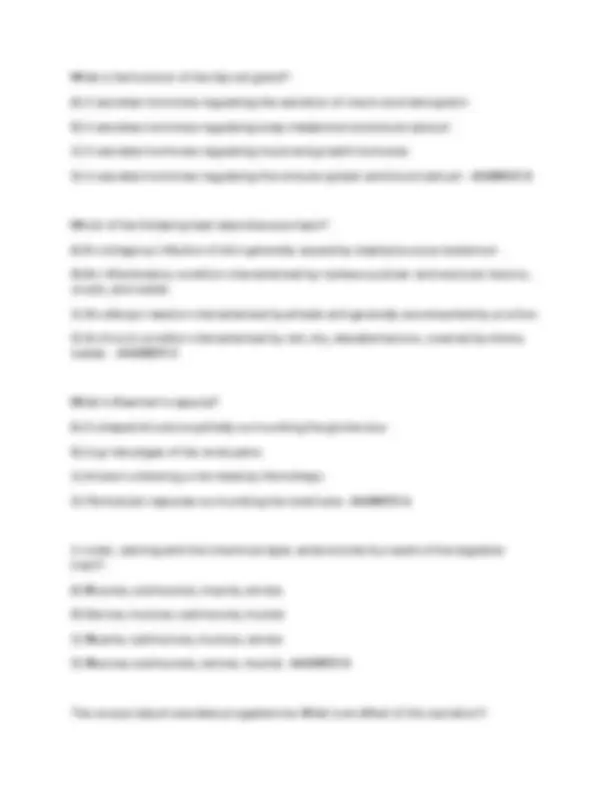
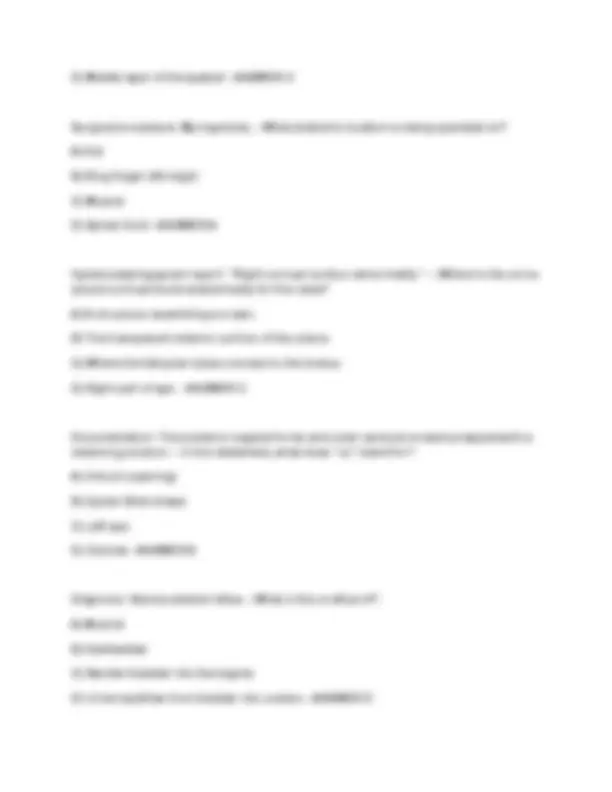

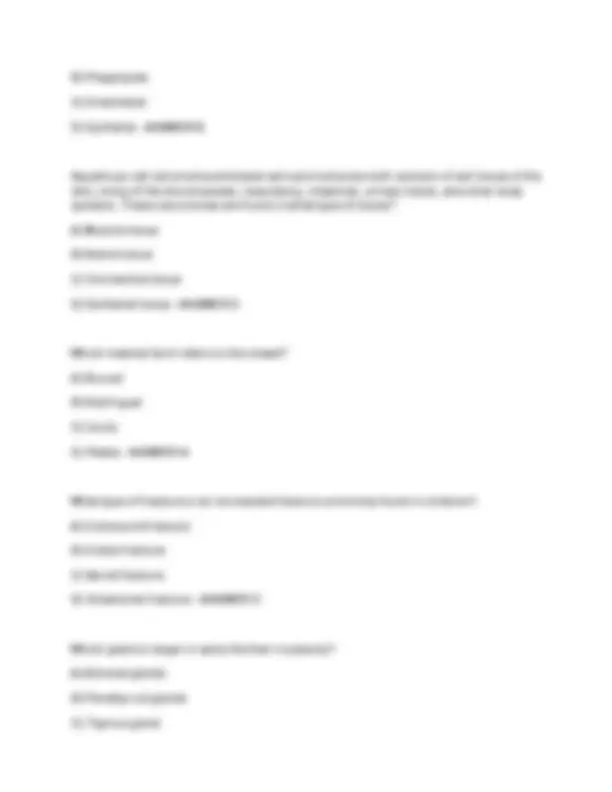
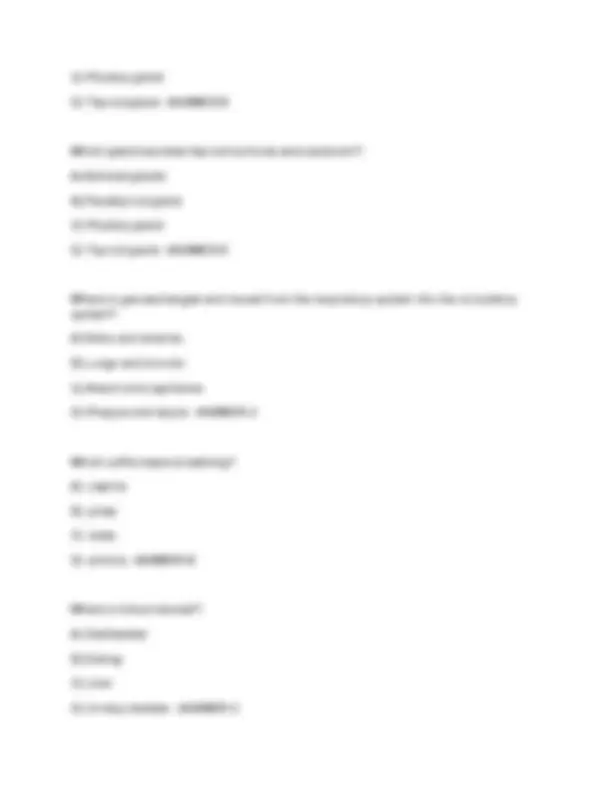
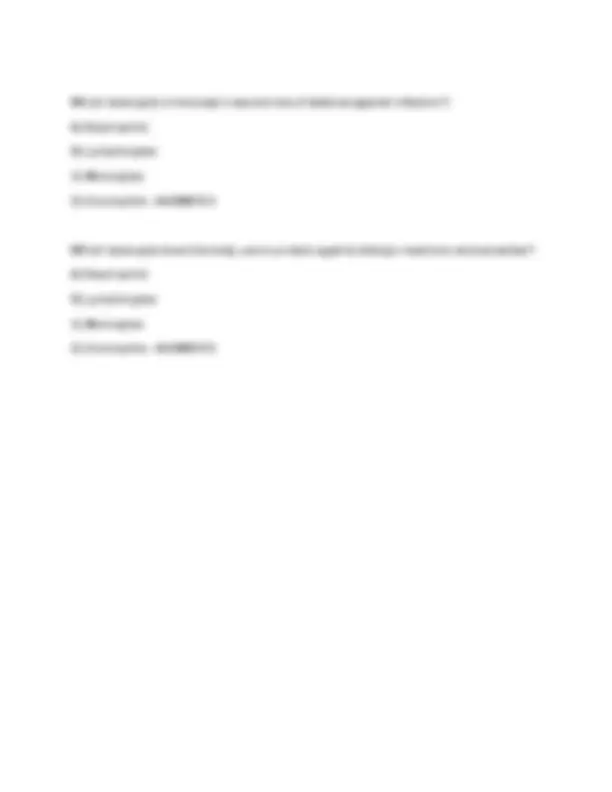


Study with the several resources on Docsity

Earn points by helping other students or get them with a premium plan


Prepare for your exams
Study with the several resources on Docsity

Earn points to download
Earn points by helping other students or get them with a premium plan
Community
Ask the community for help and clear up your study doubts
Discover the best universities in your country according to Docsity users
Free resources
Download our free guides on studying techniques, anxiety management strategies, and thesis advice from Docsity tutors
AAPC CPC ANATOMY AND TERMINOLOGY EXAM QUESTIONS AND CORRECT ANSWERS!!
Typology: Exams
1 / 14

This page cannot be seen from the preview
Don't miss anything!









A respiratory disease characterized by overexpansion and destruction of the alveoli is identified as: A) Cystic fibrosis B) Pneumoconiosis C) Respiratory distress syndrome D) Emphysema - ANSWER D
A deficiency of cells in the blood is defined as: A) Bacteremia B) Cytopenia C) Erythremia D) Phagocytosis - ANSWER B
What is the Rinne's test?: A) Test using music as the focal point B) Test for hearing loss using a vibrating tuning fork placed at the center of the head C) Test measuring hearing using bone conduction and air conduction D) Test using a two-syllable word with equal stress on each syllable - ANSWER C
The process of preserving cells or whole tissues at extremely low temperatures is known as: A) Cryopreservation B) Cryopexy C) Cryalgesia
D) Cryotherapy - ANSWER A
The term for pain in the ear is: A) Arthralgia B) Otalgia C) Myalgia D) Neuralgia - ANSWER B
A condition where the thyroid is overactive is called: A) Thyroiditis B) Thyrotoxicosis C) Ketosis D) Panhypopituitarism - ANSWER B
Adrenomegaly is defined as: A) Enlargement of the adrenal gland B) Any disease of the adrenal gland C) Infection of the adrenal gland D) A tumor of the adrenal gland - ANSWER A
A form of milk produced the first few days after giving birth is: A) Chorion B) Prolactin C) Colostrum D) Lactose - ANSWER C
Which of the following characterizes the disorder dystonia?:
C) Lung D) Trachea - ANSWER D
What is the great toe called?: A) Talus B) Hallux C) Metatarsal D) Calcaneus - ANSWER B
Upon leaving the stomach, nutrients move through the small intestine in what order? A) Jejunum, duodenum, ileum B) Jejunum, ileum, duodenum C) Duodenum, jejunum, ileum. D) Duodenum, ileum, jejunum - ANSWER C
The term episiotomy best describes a procedure of what type?: A) An incision made in the perineum to enlarge the passage for the fetus during delivery B) Removal of lining from the cervix C) A procedure to initiate cervical ripening prior to labor D) Surgical removal of an oviduct - ANSWER A
Which layer is NOT considered part of the skin?: A) Stratum corneum B) Stratum germinativum C) Epidermis D) Hypodermis - ANSWER D
What is the function of the thyroid gland?: A) It secretes hormones regulating the secretion of insulin and hemoglobin B) It secretes hormones regulating body metabolism and blood calcium C) It secretes hormones regulating mood and growth hormones D) It secretes hormones regulating the immune system and blood calcium - ANSWER B
Which of the following best describes psoriasis?: A) A contagious infection of skin generally caused by staphylococcus bacterium. B) An inflammatory condition characterized by redness pustular and vesicular lesions, crusts, and scales. C) An allergic reaction characterized by wheals and generally accompanied by pruritus. D) A chronic condition characterized by red, dry, elevated lesions, covered by silvery scales. - ANSWER D
What is Bowman's capsule? A) C-shaped structure partially surrounding the glomerulus B) Cup-like edges of the renal pelvis C) A basin collecting urine made by the kidneys D) Peritubular capsules surrounding the renal tube - ANSWER A
In order, starting with the innermost layer, what are the four walls of the digestive tract?: A) Mucosa, submucosa, muscle, serosa B) Serosa, mucosa, submucosa, muscle C) Muscle, submucosa, mucosa, serosa D) Mucosa, submucosa, serosa, muscle - ANSWER A
The corpus luteum secretes progesterone. What is an effect of this secretion?:
C) Wrist D) Bone - ANSWER C
Documentation: Suprapatellar recess showed no evidence of loose bodies or joint pathology -- What anatomic location does this refer to?: A) Knee (above the patella) B) Foot C) Liver D) Tongue - ANSWER A
Diagnosis: Kyphosis -- What anatomic location does this diagnosis most often refer to?: A) Stomach B) Vagina C) Kidney D) Thoracic Spine - ANSWER D
Documentation: Recession of left inferior rectus muscle, 5 mm. -- What anatomic location is being operated on?: A) Abdomen B) Eye C) Rectum D) Muscle of the Quadricep - ANSWER B
Documentation: There was no cleft of the uvula or submucosal palate by visual and palpable exam -- What is being examined?: A) Lips B) Vagina C) Oral cavity
D) Middle layer of the eyeball - ANSWER C
Surgical procedure: Myringotomy -- What anatomic location is being operated on? A) Ear B) Ring finger (4th digit) C) Muscle D) Spinal Cord - ANSWER A
Hysterosalpingogram report: "Right cornual contour abnormality." -- Where is the cornu (plural cornua) found anatomically for this case? A) A structure resembling a crown. B) The transparent anterior portion of the sclera. C) Where the fallopian tubes connect to the fundus. D) Right part of eye. - ANSWER C
Documentation: The posterior vaginal fornix and outer cervical os were prepped with a cleansing solution -- In this statement, what does "os" stand for?: A) Ostium (opening) B) Oyster Shell shape C) Left eye D) Outside - ANSWER A
Diagnosis: Vesicoureteral reflux -- What is this a reflux of?: A) Muscle B) Gallbladder C) Swollen bladder into the vagina D) Urine backflow from bladder into ureters - ANSWER D
B) Phagocytes C) Endothelial D) Epithelial - ANSWER B
Squamous cell carcinoma and basal cell carcinoma are both cancers of cell tissue of the skin, lining of the blood vessels, respiratory, intestinal, urinary tracts, and other body systems. These carcinomas are found in what type of tissue?: A) Muscle tissue B) Nerve tissue C) Connective tissue D) Epithelial tissue - ANSWER D
Which medical term refers to the cheek?: A) Buccal B) Sublingual C) Uvula D) Palate - ANSWER A
What type of fracture is an incomplete fracture commonly found in children?: A) Compound fracture B) Colles fracture C) Spiral fracture D) Greenstick fracture - ANSWER D
Which gland is larger in early life than in puberty?: A) Adrenal glands B) Parathyroid glands C) Thymus gland
D) Thyroid gland - ANSWER C
The brain and spinal cord are part of which system?: A) Somatic Nervous System B) Autonomic Nervous System C) Central Nervous System D) Peripheral Nervous System - ANSWER C
Which structure is an internal organ of the male genital system?: A) Epididymis B) Testes C) Cowper's glands D) Skene's glands - ANSWER C
A choledochal cyst is a cyst originating from which structure?: A) Gallbladder B) Liver C) Common bile duct D) Intestine - ANSWER C
Which part of the large intestine is between the hepatic flexure and the splenic flexure?: A) Ascending colon B) Transverse colon C) Descending colon D) Sigmoid colon - ANSWER B
What condition causes inflammation of lymphatic vessels as a result of bacterial
C) Pituitary gland D) Thyroid gland - ANSWER B
Which gland secretes thyroid hormone and calcitonin?: A) Adrenal glands B) Parathyroid gland C) Pituitary gland D) Thyroid gland - ANSWER D
Where is gas exchanged and moved from the respiratory system into the circulatory system?: A) Veins and arteries B) Lungs and bronchi C) Alveoli and capillaries D) Pharynx and larynx - ANSWER C
Which suffix means breathing?: A) -capnia B) -pnea C) -oxea D) -phonia - ANSWER B
Where is bile produced?: A) Gallbladder B) Kidney C) Liver D) Urinary bladder - ANSWER C
Which leukocyte is the body's second line of defense against infection?: A) Neutrophils B) Lymphocytes C) Monocytes D) Eosinophils - ANSWER C
Which leukocyte does the body use to protect against allergic reactions and parasites?: A) Neutrophils B) Lymphocytes C) Monocytes D) Eosinophils - ANSWER D